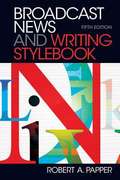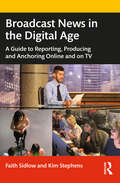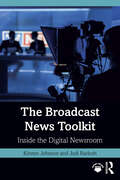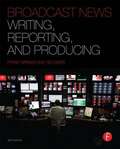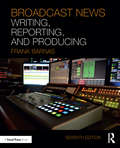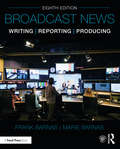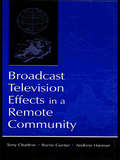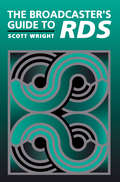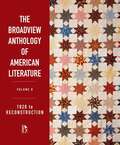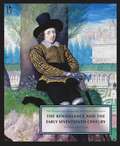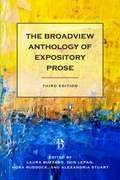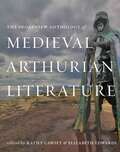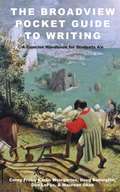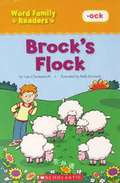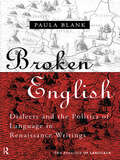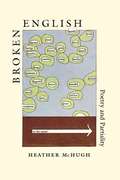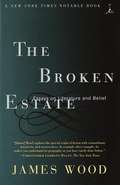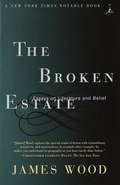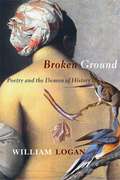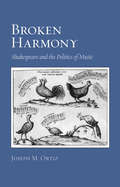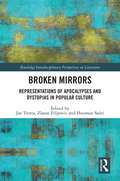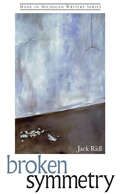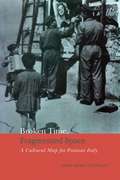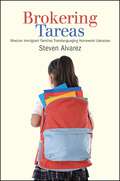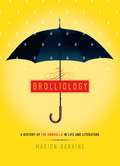- Table View
- List View
Broadcast News and Writing Stylebook -- Pearson eText
by Robert A. PapperUpdated in its 5th edition, Papper's Broadcast News and Writing Stylebook is the first and most widely used handbook in broadcast news. This book clearly and concisely outlines the rules of broadcast news writing, reporting, grammar, style, and usage. With chapter-by-chapter coverage of story types, from business stories to crime and legal reporting, education, government, health, the environment, weather, and sports, the Broadcast News and Writing Stylebook lays out the particular demands of composition, form, style, and usage in all the diverse areas of broadcast news. Because the news business has changed -- and continues to evolve -- so has this text.Written by the person who has overseen the major industry research for the past 18 years, the latest edition looks into the future of news by exploring the business of news. Citing the latest data and trends, the book takes a hard look at where the industry stands and where it appears to be headed.
Broadcast News in the Digital Age: A Guide to Reporting, Producing and Anchoring Online and on TV
by Kim Stephens Faith M SidlowWritten by two award-winning broadcast journalists, this book offers a practical, hands-on guide to the modern digital TV newsroom. Pulling from extensive industry experience, the authors provide a comprehensive look at the key journalistic skills needed to excel in broadcast news today, including storytelling, writing, story pitching, video production, interviewing and managing social media. The textbook is organized into five sections: building a foundation, storytelling and writing, producing, live performance, and ethics and career progression. The authors also provide step-by-step instructions on how to efficiently multitask while staying true to journalist ethics. Each chapter includes clear learning objectives, review questions and practical assignments, making it ideal for classroom use. QR codes integrated in the text allow students to easily see and hear examples of the stories they are learning to write. Broadcast News in the Digital Age is an engaging, student-friendly guide for those seeking to become successful writers, producers, anchors and journalists in today’s newsrooms, both on-air and online.
The Broadcast News Toolkit: Inside the Digital Newsroom
by Kirsten Johnson Jodi RadoshThe Broadcast News Toolkit focuses on the writing, shooting, and production of broadcast news across multimedia platforms in a non-technical and visually engaging way. Covering a range of different story forms in broadcast news (RDR, FS, VO, VO/SOT, PKG, and Liveshots), this book illustrates basic audio/video shooting and editing techniques through straightforward examples, including online video tutorials that can be accessed via a QR code within the book. Specific issues relating to online content, social media, and audience engagement are discussed in detail, and the authors further explore why trust in news media is declining, the impact that fake news and deep fake videos have on media credibility in newsrooms, and what can be done to increase the perceived credibility of the news. Students will also learn how to write leads and teases that will keep viewers engaged. This is an ideal text for undergraduate and graduate students of Broadcast and Multimedia Journalism who are looking for a clear and concise guide to the modern digital newsroom.
Broadcast News Writing, Reporting, and Producing
by Frank BarnasJargon buster: convergent journalism: ?Media convergence is the most significant development in the news industry in the last century. The ability to interchange text, audio, and visual communication over the Internet has fundamentally transformed the way news organizations operate. Convergence has enabled media companies to gather, disseminate, and share information over a variety of platforms. Throughout the history of journalism, it has been common for journalists to study one medium, such as traditional print or broadcast, and to anticipate a career working only in their chosen field. However, the 21st century journalist has fluidity to write and deliver news content in a variety of formats. (source: http://www.convergencejournalism.com/) Broadcast News Writing, Reporting, and Producing presents a solid foundation for any student learning how to become a broadcast journalist ? in today's world of convergent journalism, it is more important than ever that broadcast textbooks cover the most current trends in media. Convergent journalism (the coverage of news across multiple delivery platforms such as the internet, television, podcasts, ipods, blogs, etc) is here to stay ? broadcast journalism continues to morph as newer and more advanced content platforms are hatched and developed, and broadcast journalists must understand how to write, report, and produce for multiple platforms simultaneously. Just one crucial fact remains: students will need training on how to perform successfully in a world in which current events aren't just shown on the ten o'clock evening news.Broadcast News Writing, Reporting, and Producing will be completely overhauled to reflect the trends of convergent journalism on every page. New co-author Frank Barnas brings a multi-faceted perspective of writing, reporting, and producing that allows for multi-platform delivery systems, and shows students with real-world examples the functions and practices of today's media. The new edition will be rewritten and restructured to accommodate common 16-week course modules, and will be divided into four major sections of the news: gathering, writing, reporting, and producing. Sidebars featuring how examples used in the text relate to convergence in journalism help students to draw connections easily between current stories and trends in the industry. The comprehensive approach of this text brings a multi-faceted perspective of writing, reporting, and producing that is needed more than ever in today's world of convergent journalism. This newest edition is being completely overhauled by the experienced journalist Frank Barnas. New photos and illustrations, a restructuring of the text, expanded end-of-chapter exercises, newer and more relevant examples, and more information on producing all contribute to giving readers what they need most: a nuanced understanding of how the media of today function in a world without news boundaries.
Broadcast News Writing, Reporting, and Producing
by Frank BarnasBroadcast News Writing, Reporting, and Producing, 7th Edition is the leading book covering all aspects of writing and reporting the news. It identifies the key concepts and terms readers need to know in the news gathering and dissemination process, and provides practical, real-world advice for operating in the modern day newsroom. New to the seventh Edition are profiles of working journalists who give readers a glimpse into the working life of modern reporters, producers, and directors. This new edition also covers important aspects of the use of social media, drone journalism, and digital technology. A new chapter on portfolio development will assist readers in developing the skills to advance in their careers. The text has also been updated to reflect new industry standards in modes of information gathering and delivery, writing style, and technology. Additional features include: Key words at the start of every chapter, identifying important terms and definitions; End of chapter summaries, which allows readers to review the chapter’s main points; "Text Your Knowledge", which helps readers quiz themselves on important concepts; Chapter-by-chapter exercises, which readers can apply to a chapter’s themes; A companion website featuring video tutorials of necessary skills for journalists, including how to arrange lighting structures, how to hold a microphone, and how to properly conduct an interview.
Broadcast News Writing, Reporting, and Producing
by Frank Barnas Marie BarnasNow in its eighth edition, Broadcast News Writing, Reporting, and Producing is the industry’s leading textbook covering all aspects of the three pillars of broadcast news. The book discusses the key strategies and terms of newsgathering and delivery by providing real-world, professional advice for broadcast journalists in the modern-day newsroom. New to the eighth edition is the Best Apps feature, which identifies the most productive apps used by working journalists when covering stories. The book also covers the ever increasing diversity of the journalism field and brings in new voices from professionals working in the industry to discuss these topics. Other new additions include in-depth discussions of fake news, expanded coverage of social media in the newsroom, and an overview of the latest advances in technology available to television and radio news reporters. Broadcast News Writing, Reporting, and Producing remains the best book for undergraduate students in journalism writing, producing, newsgathering, and multimedia courses. An accompanying companion website features resources to help instructors deliver online courses, including Powerpoints, Quizlets, and a sample syllabus.
Broadcast Television Effects in A Remote Community (Routledge Communication Series)
by Tony Charlton Barrie Gunter Andrew HannanThis book reports findings from a major, multidisciplinary study of the impact of broadcast television on the remote island community of St. Helena in the South Atlantic Ocean. Broadcast television was introduced to the island for the first time in March 1995. This introduction represented a major event on the island, whose only televisual experience had been through video. In the years leading up to the introduction of TV, the researchers who wrote this book collected data by observing the island's young children in classroom settings, and during free-play. In addition to these observations they asked the children's teachers to rate their students' behavior, and invited the children to explain to them what leisure time activities they engaged in. With the data they were able to amass on these key variables they have assembled and coded the results into baseline measures central to the study. Once TV had arrived, they collected data annually on the key dependent measures to determine if the introduction of broadcast TV had any discernible influence on the behavior of the children.
The Broadcaster's Guide to RBDS
by Scott WrightThis handbook is intended to give the broadcast industry an authoritative guide to the Radio Data System (RDS), also called Radio Broadcast Data System (RBDS). Since the standard's adoption, about 700 stations have begun broadcasting RDS in the United States. There is a wide variety of encoding equipment with prices starting as low as $400, and over 30 models of RDS receivers have been introduced for cars, home receivers, portable and even PC receivers. Automobile manufacturer's such as General Motors, Ford, Audi, and Porsch now offer RDS on new vehicles. Yet despite all the support equipment in place, the FM broadcaster has been reluctant to implement and utilize this service, mainly because of a lack of understanding of what RDS can do for the station. This book finally provides the information required to understand RDS and its possibilities on a variety of levels, so that everyone involved in radio can make the most of it. Station owner, program director, salesperson, and talent alike will find the information he or she requires to maximize the possibilities of this new technology. Each feature of the system is explained in terms of its practical implementation at the station, and interviews with broadcasters currently using the system add a hands-on perspective. Scott Wright is a recognized pioneer in RDS development. As the designer of Delco Electronics' first RDS receiver, he has been extremely active in the development of the RDS standard in the US and in efforts to educate the broadcast community about its potential. He has represented Delco at the European Broadcasting Union's (EBU) RDS Forum and is currently the Chairman of the National Radio Systems Committee RBDS Subcommittee, the US standard-setting body. He is also a member of the Electronics Industries Association's (EIA) RDS Forum.
The Broadview Anthology of American Literature Volume B: 1820 to Reconstruction
by Rachel Greenwald Smith Michael Everton Christine Bold Hsuan L. Hsu Laura L. Mielke Justine S. Murison Derrick R. Spires Christina Roberts Joe Rezek Christopher Looby Rodrigo Lazo Alisha KnightAbout the Anthology <p><p>Covering American literature from its pre-contact Indigenous beginnings through the Reconstruction period, the first two volumes of The Broadview Anthology of American Literature represent a substantial reconceiving of the canon of early American literature. Guided by the latest scholarship in American literary studies, and deeply committed to inclusiveness, social responsibility, and rigorous contextualization, the anthology balances representation of widely agreed-upon major works with an emphasis on American literature’s diversity, variety, breadth, and connections with the rest of the Americas. <p><p>Volume A, which covers Beginnings to 1820, is available separately or packaged together with Volume B; a concise volume covering Beginnings to Reconstruction is also available. Volumes covering Reconstruction to the Present are in development. <p><p>Highlights of Volume B: 1820 to Reconstruction <p><p>• Complete texts of Narrative of the Life of Frederick Douglass, An American Slave; and Benito Cereno <p><p>• In-depth, Contexts sections on such topics as “Nature and the Environment,” “Expansion, Native American Expulsion, and Manifest Destiny,” “Gender and Sexuality,” and “Oratory” <p><p>• Broader and more extensive coverage of African American oral literature than in competing anthologies <p><p>• Full author sections in the anthology are devoted to authors such as George Moses Horton, Jane Johnston Schoolcraft, José Maria Heredia, Black Hawk, and many others <p><p>• Extensive online component offers well over a thousand pages of additional readings and other resources Read less
The Broadview Anthology Of British Literature: The Renaissance And The Early Seventeenth Century
by Joseph Black Claire Waters Leonard Connolly Kate Flint Isobel Grundy Don LePan Roy Liuzza Jerome J. McGann Anne Lake Prescott Barry V. QuallsIn all six of its volumes The Broadview Anthology of British Literature presents British literature in a truly distinctive light. Fully grounded in sound literary and historical scholarship, the anthology takes a fresh approach to many canonical authors, and includes a wide selection of work by lesser-known writers. The anthology also provides wide-ranging coverage of the worldwide connections of British literature, and it pays attention throughout to issues of race, gender, class, and sexual orientation. It includes comprehensive introductions to each period, providing in each case an overview of the historical and cultural as well as the literary background. It features accessible and engaging headnotes for all authors, extensive explanatory annotations, and an unparalleled number of illustrations and contextual materials. Innovative, authoritative and comprehensive, The Broadview Anthology of British Literature has established itself as a leader in the field. <p><p> The full anthology comprises six bound volumes, together with an extensive website component; the latter has been edited, annotated, and designed according to the same high standards as the bound book component of the anthology, and is accessible by using the passcode obtained with the purchase of one or more of the bound volumes. <p> For the third edition of this volume a considerable number of changes have been made. Newly prepared, for example, is a substantial selection from Baldassare Castiglione’s The Courtier, presented in Thomas Hoby’s influential early modern English translation. Thomas Kyd’s The Spanish Tragedy is another major addition. Also new to the anthology are excerpts from Thomas Dekker’s plague pamphlets. We have considerably expanded our representation of Elizabeth I’s writings and speeches, as well as providing several more cantos from Edmund Spenser’s Faerie Queene and adding selections from Sir Philip Sidney’s Arcadia. We have broadened our coverage, too, to include substantial selections of Irish, Gaelic Scottish, and Welsh literature. (Perhaps most notable of the numerous authors in this section are two extraordinary Welsh poets, Dafydd ap Gwilym and Gwerful Mechain.) Mary Sidney Herbert’s writings now appear in the bound book instead of on the companion website. Margaret Cavendish, previously included in volume 3 of the full anthology, will now also be included in this volume; we have added a number of her poems, with an emphasis on those with scientific themes. <p< The edition features two new Contexts sections: a sampling of “Tudor and Stuart Humor,” and a section on “Levellers, Diggers, Ranters, and Covenanters.” New materials on emblem books and on manuscript culture have also been added to the “Culture: A Portfolio” contexts section. <p> There are many additions the website component as well―including Thomas Deloney’s Jack of Newbury also published as a stand-alone BABL edition). We are also expanding our online selection of transatlantic material, with the inclusion of writings by John Smith, William Bradford, and Anne Bradstreet.
The Broadview Anthology of Expository Prose: Third Edition
by Don LePan Laura Buzzard Nora Ruddock Alexandria StuartThe third edition of this anthology has been substantially revised and updated for a contemporary American audience; a selection of classic essays from earlier eras has been retained, but the emphasis is very much on twenty-first-century expository writing. Works of different lengths and levels of difficulty are represented, as are narrative, descriptive and persuasive essays―and, new to this edition, lyric essays. For the new edition there are also considerably more short pieces than ever before; a number of op-ed pieces are included, as are pieces from blogs and from online news sources. The representation of academic writing from several disciplines has been increased―and in some cases the anthology also includes news reports presenting the results of academic research to a general audience. Also new to this edition are essays from a wide range of the most celebrated essayists of the modern era―from James Baldwin, Susan Sontag, Joan Didion, and Annie Dillard to Eula Biss and Ta-Nehisi Coates. <p><p> The anthology remains broad in its thematic coverage, but certain themes receive special emphasis―notably, issues of race, class, and culture in twenty-first century America. <p> For the new edition the headnotes have been expanded, providing students with more information as to the context in which each piece was written. Questions and suggestions for discussion have been moved online to the instructor website.
The Broadview Anthology Of Medieval Arthurian Literature
by Kathy Cawsey Elizabeth EdwardsThis teaching anthology collects texts from the vast archive of medieval Arthurian literature. It includes selections from mainstream canonical authors, such as Geoffrey of Monmouth and Sir Thomas Malory, and more peripheral works, such as the Melech Artus (a twelfth-century Hebrew text) and the Dutch Morien (featuring a black knight). In this it differs from other anthologies of medieval Arthuriana: it is more inclusive and diverse than previous collections. Characters and authors showcase the diversity of race, religion, gender, and gender orientation of the Arthurian tradition. As well, this anthology and its accompanying website include a variety of genres, ranging from visual art to sculpture, from historical chronicles to romance and drama. Arthurian works, while concentrated in England, France, and Wales, are found across medieval Europe; this anthology therefore includes texts from Iceland to Greece. The Broadview Anthology of Medieval Arthurian Literature is ideally suited to teaching: it includes full texts, such as Chrétien de Troyes’s Knight of the Cart, Chaucer’s “Wife of Bath’s Tale,” and the anonymous Sir Gawain and the Green Knight, for classes that wish to study a whole work in depth; it also includes shorter excerpts of parallel incidents, such as the Uther and Igraine story, so that students can compare a story’s treatment by different authors. Marginal glosses assist students with the Middle English texts, while introductory notes and explanatory footnotes give students necessary background information.
The Broadview Pocket Guide to Writing: A Concise Handbook for Students
by Corey Frost Karen Weingarten Doug Babington Don LePan Maureen OkunThe Broadview Pocket Guide to Writing is a concise volume presenting essential material from the full Broadview Guide to Writing. Included are summaries of key grammatical points; a glossary of usage; advice on various forms of academic writing; coverage of punctuation and writing mechanics; helpful advice on how to research academic papers; and much more. Four commonly-used styles of citation and documentation are covered-MLA, APA, Chicago, and CSE. The revised fourth edition includes full coverage of the 2016 MLA Style changes.
Brock's Flock (Word Family Readers)
by Liza CharlesworthBrock's flock lives in a giant sock! Learn more shocking facts about his flock in this silly story that teaches lots and lots of -ock words! Let's Learn Readers boost key literacy skills through engaging, easy-to-read stories. Share this super-fun book with your child to jumpstart phonics learning!
Broken English: Dialects and the Politics of Language in Renaissance Writings (The Politics of Language)
by Paula BlankThe English language in the Renaissance was in many ways a collection of competing Englishes. Paula Blank investigates the representation of alternative vernaculars - the dialects of early modern English - in both linguistic and literary works of the period. Blank argues that Renaissance authors such as Spenser, Shakespeare and Jonson helped to construct the idea of a national language, variously known as 'true' English or 'pure' English or the 'King's English', by distinguishing its dialects - and sometimes by creating those dialects themselves. Broken English reveals how the Renaissance 'invention' of dialect forged modern alliances of language and cultural authority. This book will be of interest to scholars and students of Renaissance studies and Renaissance English literature. It will also make fascinating reading for anyone with an interest in the history of English language.
Broken English: Poetry and Partiality
by Heather Mchugh"When I call poetry a form of partiality," writes Heather McHugh, "I mean its economies operate by powers of intimation: glimmering and glints, rather than exhaustible sums. It is a broken language from the beginning, brimming with non-words: all that white welled up to keep the line from surrendering to the margin; all that quiet, to keep the musics marked." In Broken English, McHugh applies her poetic sensibility and formidable critical insight to topics ranging from the poetry of Valery and Rilke to ancient Greek drama and Yoruba folk songs, offering intense, passionate, highly personal readings that are informed and unified by her concern for the relationships among language, culture, and poetry. Ebook Edition Note: All images have been redacted.
The Broken Estate: Essays on Literature and Belief
by James WoodThis book recalls an era when criticism could change the way we look at the world. In the tradition of Matthew Arnold and Edmund Wilson, James Wood reads literature expansively, always pursuing its role in our lives.
The Broken Estate
by James WoodThis book recalls an era when criticism could change the way we look at the world. In the tradition of Matthew Arnold and Edmund Wilson, James Wood reads literature expansively, always pursuing its role and destiny in our lives. In a series of essays about such figures as Melville, Flaubert, Chekhov, Virginia Woolf, and Don DeLillo, Wood relates their fiction to questions of religious and philosophical belief. He suggests that the steady ebb of the sea of faith has much to do with the revo-lutionary power of the novel, as it has developed over the last two centuries. To read James Wood is to be shocked into both thinking and feeling how great our debt to the novel is. In the grand tradition of criticism, Wood's work is both commentary and literature in its own right--fiercely written, polemical, and richly poetic in style. This book marks the debut of a masterly literary voice.
Broken Ground: Poetry and the Demon of History
by William LoganIn Broken Ground, William Logan explores the works of canonical and contemporary poets, rediscovering the lushness of imagination and depth of feeling that distinguish poetry as a literary art. The book includes long essays on Emily Dickinson’s envelopes, Ezra Pound’s wrestling with Chinese, Robert Frost’s letters, Philip Larkin’s train station, and Mrs. Custer’s volume of Tennyson, each teasing out the depths beneath the surface of the page.Broken Ground also presents the latest run of Logan’s infamous poetry chronicles and reviews, which for twenty-five years have bedeviled American verse. Logan believes that poetry criticism must be both adventurous and forthright—and that no reader should settle for being told that every poet is a genius. Among the poets under review by the “preeminent poet-critic of his generation” and “most hated man in American poetry” are Anne Carson, Jorie Graham, Paul Muldoon, John Ashbery, Geoffrey Hill, Louise Glück, John Berryman, Marianne Moore, Frederick Seidel, Les Murray, Yusef Komunyakaa, Sharon Olds, Johnny Cash, James Franco, and the former archbishop of Canterbury.Logan’s criticism stands on the broken ground of poetry, soaked in history and soiled by it. These essays and reviews work in the deep undercurrents of our poetry, judging the weak and the strong but finding in weakness and strength what endures.
Broken Harmony: Shakespeare and the Politics of Music
by Joseph M. OrtizMusic was a subject of considerable debate during the Renaissance. The notion that music could be interpreted in a meaningful way clashed regularly with evidence that music was in fact profoundly promiscuous in its application and effects. Subsequently, much writing in the period reflects a desire to ward off music’s illegibility rather than come to terms with its actual effects. In Broken Harmony Joseph M. Ortiz revises our understanding of music’s relationship to language in Renaissance England. In the process he shows the degree to which discussions of music were ideologically and politically charged. Offering a historically nuanced account of the early modern debate over music, along with close readings of several of Shakespeare’s plays (including Titus Andronicus, The Merchant of Venice, The Tempest, and The Winter’s Tale) and Milton’s A Maske, Ortiz challenges the consensus that music’s affinity with poetry was widely accepted, or even desired, by Renaissance poets. Shakespeare more than any other early modern poet exposed the fault lines in the debate about music’s function in art, repeatedly staging disruptive scenes of music that expose an underlying struggle between textual and sensuous authorities. Such musical interventions in textual experiences highlight the significance of sound as an aesthetic and sensory experience independent of any narrative function.
Broken Mirrors: Representations of Apocalypses and Dystopias in Popular Culture (Routledge Interdisciplinary Perspectives on Literature)
by Joe Trotta Zlatan Filipovic Houman SadriDystopian stories and visions of the Apocalypse are nothing new; however in recent years there has been a noticeable surge in the output of this type of theme in literature, art, comic books/graphic novels, video games, TV shows, etc. The reasons for this are not exactly clear; it may partly be as a result of post 9/11 anxieties, the increasing incidence of extreme weather and/or environmental anomalies, chaotic fluctuations in the economy and the uncertain and shifting political landscape in the west in general. Investigating this highly topical and pervasive theme from interdisciplinary perspectives this volume presents various angles on the main topic through critical analyses of selected works of fiction, film, TV shows, video games and more.
Broken Symmetry: Broken Symmetry
by Jack RidlMichigan poet Jack Ridl leads readers into reflective connection with the everyday world in this unique and enjoyable volume.
Broken Time, Fragmented Space: A Cultural Map of Postwar Italy (The Royal Society of Canada Special Publications)
by Anna Maria TorrigliaBroken Time, Fragmented Space: A Cultural Map for Post-war Italy examines how the artists and intellectuals of post-war Italy dealt with the 'shameful' heritage of their fascist upbringing and education by trying to craft a new cultural identity for themselves and the country. The continuities between the culture of the fascist and post-fascist periods were, however, far greater than what intellectuals were ready to admit, creating an uncomfortable, sometimes schizophrenic relation to time, as a painful urge to erase the past.Drawing on a variety of critical approaches, Torriglia investigates the efforts to reconstruct a personal as well as a collective self by analyzing both canonical and lesser-known cinematic and literary texts. Organized around four main themes - the use of language, the interaction between personal and public spheres, the perceptual categories of history and memory, and the reconstruction of the female identity - the study also includes historical introductions and sociological commentary that provides an extensive and captivating picture of the cultural production in 1950s Italy, a period that has not yet been extensively studied.
Brokering Tareas: Mexican Immigrant Families Translanguaging Homework Literacies
by Steven AlvarezWinner of the 2019 Outstanding Book in Community Writing Award presented by the Coalition for Community WritingBrokering Tareas examines a grassroots literacy mentoring program that connected immigrant parents with English language mentors who helped emerging bilingual children with homework and encouraged positive academic attitudes. Steven Alvarez gives an ethnographic account of literacies practices, language brokering, advocacy, community-building, and mentorship among Mexican-origin families at a neighborhood afterschool program in New York City. Alvarez argues that engaging literacy mentorship across languages can increase parental involvement and community engagement among immigrant families, and offers teachers and researchers possibilities for rethinking their own practices with the communities of their bilingual students.
Brolliology
by Marion RankineA fun, illustrated history of the umbrella's surprising place in life and literatureHumans have been making, using, perfecting, and decorating umbrellas for millennia--holding them over the heads of rulers, signalling class distinctions, and exploring their full imaginative potential in folk tales and novels. In the spirit of the best literary gift books, Brolliology is a beautifully designed and illustrated tour through literature and history. It surprises us with the crucial role that the oft-overlooked umbrella has played over centuries--and not just in keeping us dry. Marion Rankine elevates umbrellas to their rightful place as an object worthy of philosophical inquiry. As Rankine points out, many others have tried. Derrida sought to find the meaning (or lack thereof) behind an umbrella mentioned in Nietzsche's notes, Robert Louis Stevenson wrote essays on the handy object, and Dickens used umbrellas as a narrative device for just about everything. She tackles the gender, class, and social connotations of carrying an umbrella and helps us realize our deep connection to this most forgettable everyday object--which we only think of when we don't have one.
